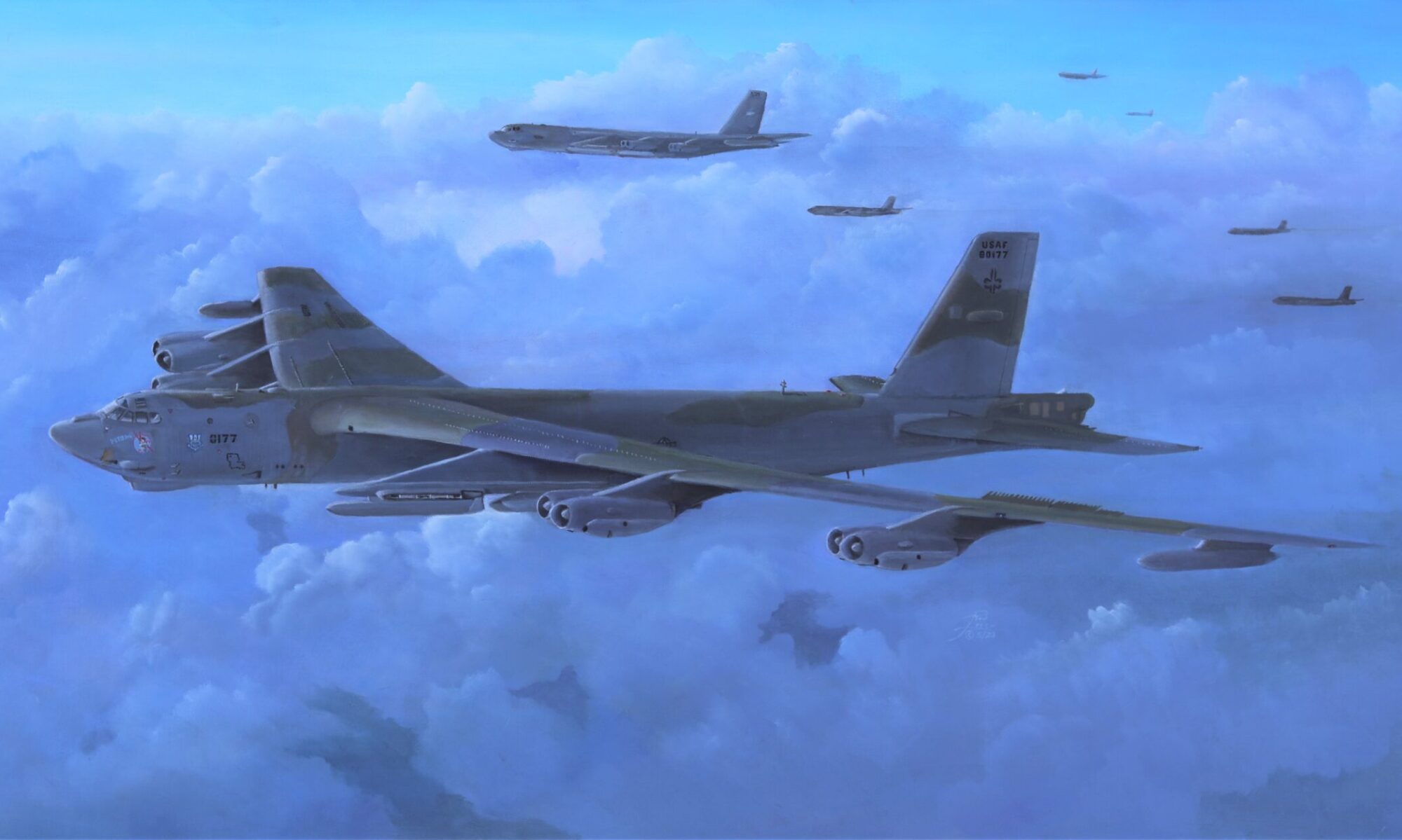2019 ASAA International Aerospace Art Exhibit
AWARD WINNERS
at the National Museum of the USAF, Dayton, Ohio 2019
Exhibition: May 6, 2019 – Oct. 31, 2019
LUTHER Y. GORE
Distinguished Service Award
Ardell Bourgeois
JAMES V. ROY AWARD
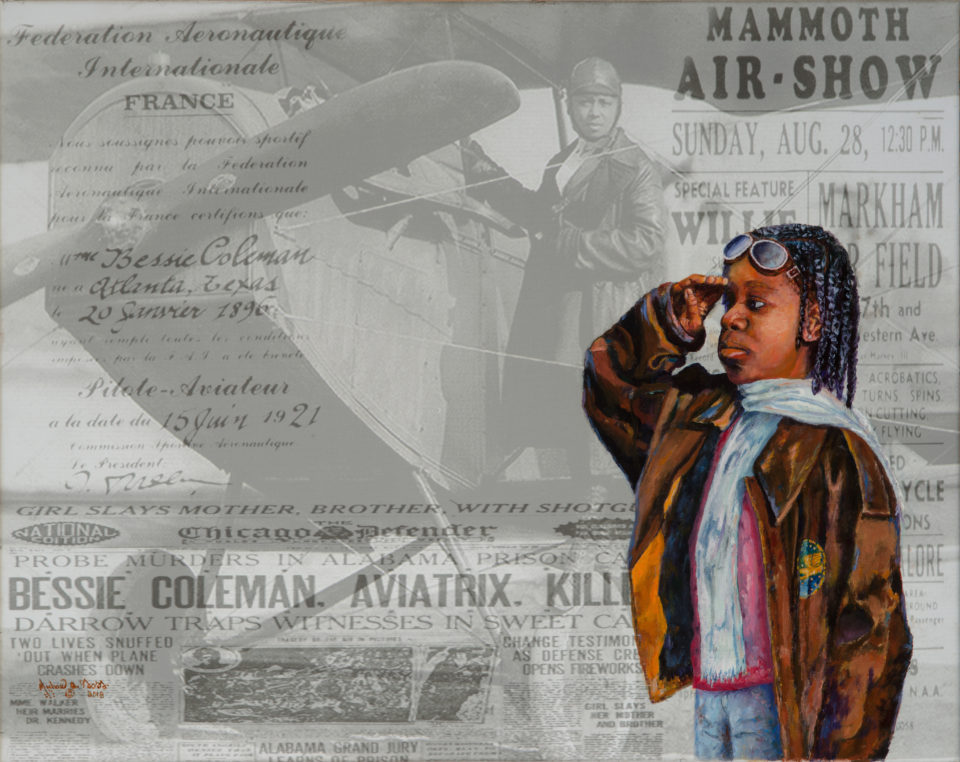
“Bessie Coleman – My Dream”
Mixed Media 24 x 30
A little girl stands in front of Bessie Coleman news clippings dreaming that one day “that will be me”.
AWARD OF DISTINCTION
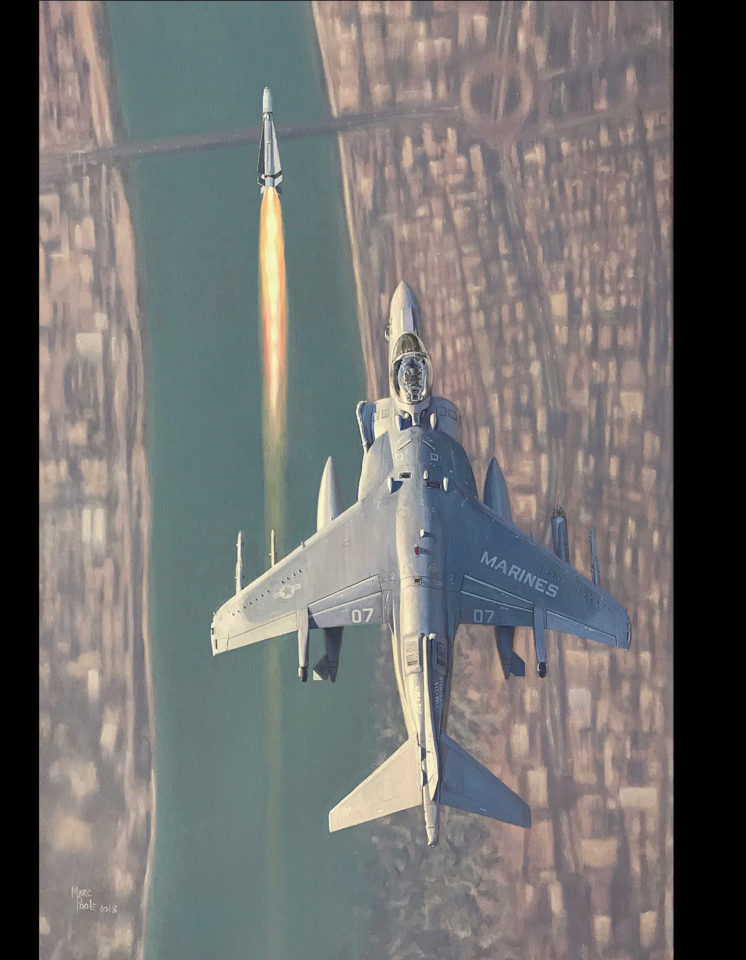
“Black Sheep Over Bahgdad”
Oil 36 x 24
On April 9, 2003, US Marines toppled the statue of Saddam Hussein in Baghdad, Iraq, as they pushed through the city. The next afternoon, VMA-214 pilot Captain Tyler “Hefty” Bardo was flying USMC AV-8B Harrier II+ BuNo 165567, when he was directed to provide close air support over the Iraqi capital. Hostile forces were firing RPG’s from a clock tower at Marine forces on the ground in Baghdad, resulting in the death of one of the Marines. After flying a requested practice run, Bardo’s flight leader made an attack with a laser-guided bomb, which proved to be a dud. A third run was made with Bardo attempting to use his AGM-65E Maverick missile, but failed to get a lock on the target. He then descended to 7,000′ for a fourth run, launching his LMAV approximately five miles away from the target, flying northwest along the banks of the Tigris River. The LMAV scored a direct hit on the tower, eliminating the threat.
AWARD OF MERIT
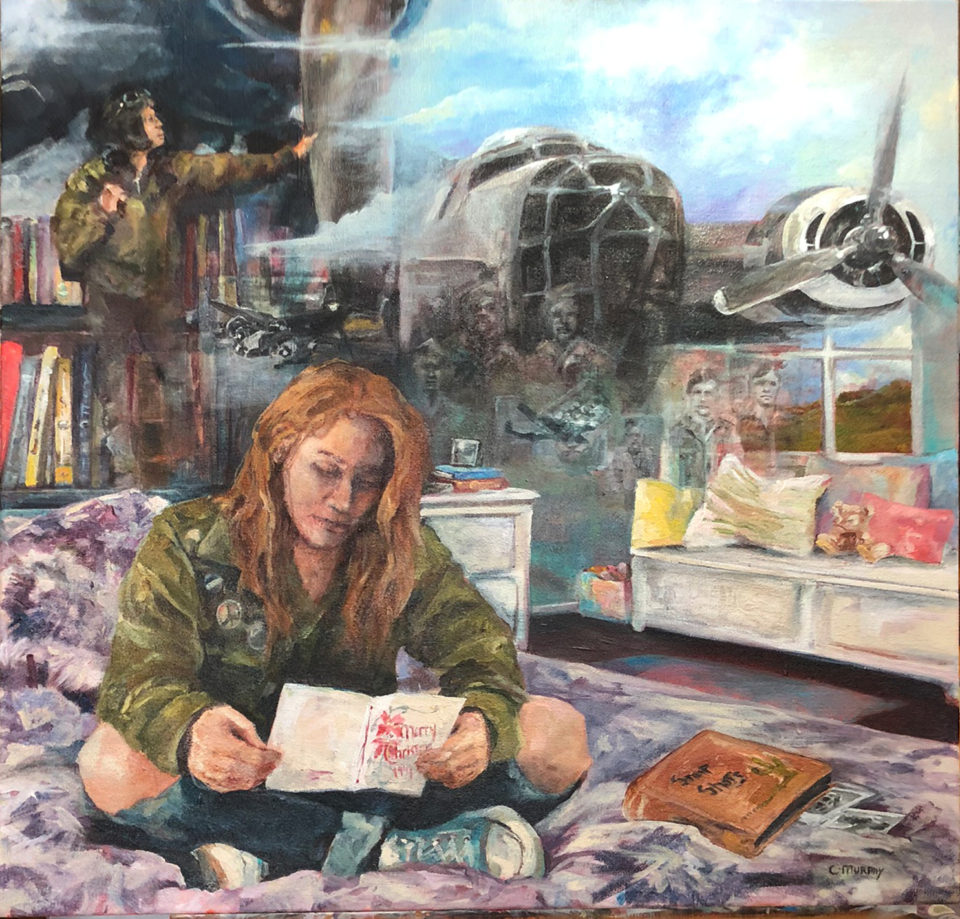
“All the Stories Grandpa
Told”
Acrylic 36 x 36
As she looks through her
Grandfather’s WWII memorabilia, a young girl remembers his stories and her
imagination takes flight.
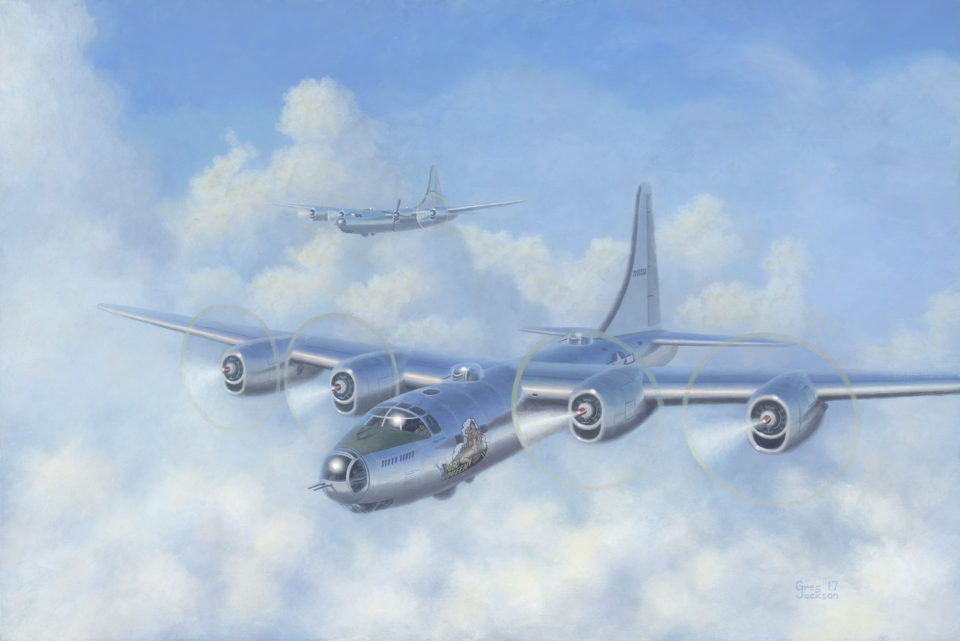
“The Last One to Fall”
Oil 24 x 36
On August 18, 1945, three days after the Japanese announced their surrender, two B-32 Dominator bombers on a photo reconnaissance mission were attacked by Japanese fighters over Tokyo. Sgt. Anthony J. Marchiano, a photographer in the second aircraft, was killed. He was the last American airman to die in World War II.
HONORABLE MENTIONS

“O’er the Ramparts They Watched”

“MIG 46”
Oil 18 x 24
This MiG 17A outside the National Museum of the Mighty Eighth Air Force in Pooler, GA, bears an eye-catching, red number 46. The MiG is painted in camouflage used by the North Vietnamese Air Force.
Priscilla Messner-Patterson
“Dancing with the Northern Lights”
Watercolor 12 x 16
The light shows are more often visible in interior climates and rarely seen in coastal communities due to cloud cover. An unusual sight on a clear night in Kodiak’s Trident Basin floatplane harbor shines colors on a DeHavilland Otter.
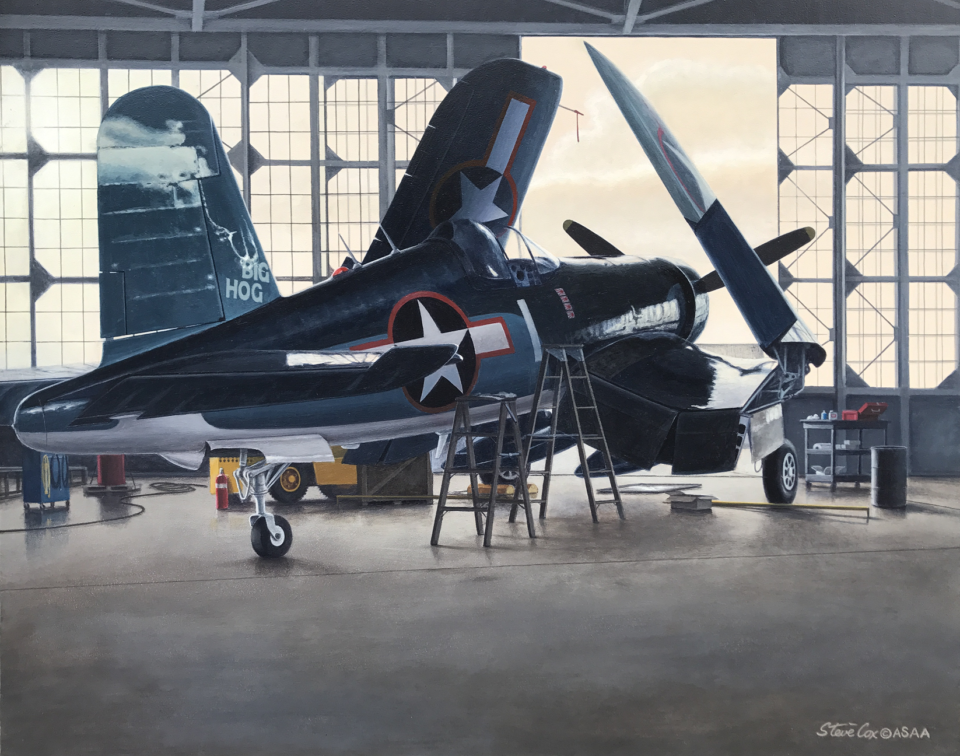
“Big Hog”
Acrylic 16 x 20
In the 1980s, Paine Field in Everett, WA was pretty open to aviation geeks. My first up-close encounter with a flyable warbird was this Goodyear built FG-1D Corsair named “Big Hog.” It was hangared in an ex-Alaska Airlines maintenance center along with an ever-changing variety of interesting civil and ex-military aircraft, and I soon became a regular pest there. The late Jim Landry restored the fighter once operated by the New Zealand Air Force over a ten-year period and flew it at many northwest airshows.
ASAA SPONSORED
Category Awards
COMMERCIAL
1st Place
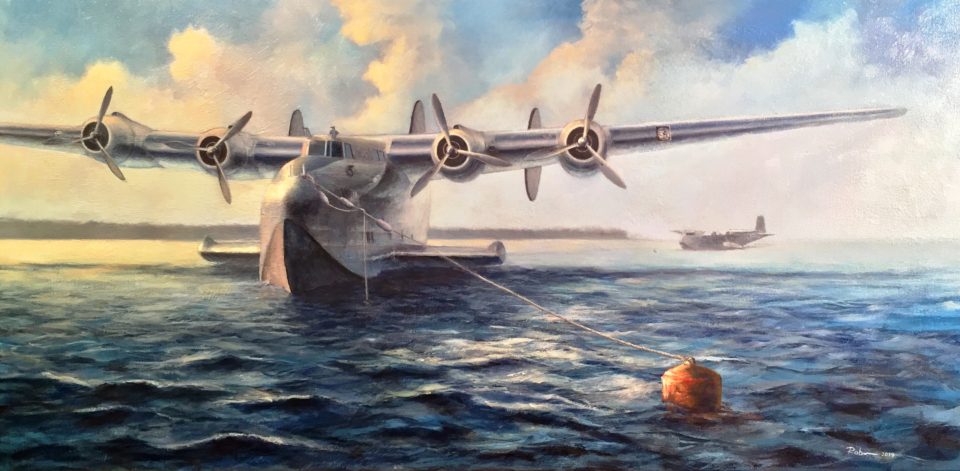
“Boeing 314 Clipper”
Oil 15 x 30
The Boeing 314 Clipper was a long-range flying boat produced by the Boeing Airplane Company between 1938 and 1941. One of the largest aircraft of the time, it used the massive wing of Boeing’s earlier XB-15 bomber prototype to achieve the range necessary for flights across the Atlantic and Pacific Oceans. Twelve Clippers were built; nine were brought into service for Pan Am.
2nd Place

“Palm Springs, Alaska”
Oil 6 x 12
An Alaska Airlines 737-900 taxies to the terminal after landing at the Palm Springs International Airport.
3rd Place

“Denali and the Helio Courier”
Watercolor 30 x 22
This image is part of the ‘Denali’ series currently on my drawing board. This Alaskan mountain has many faces, perfect for providing continuous inspiration. For search and rescue purposes, many aircraft are painted red. Watercolor seemed the perfect medium to capture the crisp, cold scene.
SPACE
1st Place

“Loons Over Puerto Rico After Maria”
Oil 36 x 24
High altitude Loon balloons helped provide Puerto Rico and the U.S. Virgin Islands with internet and cellular connectivity after Hurricane Maria dealt devastating destruction in September, 2017. The high altitude super pressure helium-filled Loon balloons carried communication antennas with solar panels aloft to float in the stratosphere over the islands, replacing signals for crippled cell phone towers. Alphabet X’s Project Loon, through research with balloon manufacturer Raven, could keep a balloon aloft for more than 100 days and control its location by utilizing sophisticated algorithms to capture varied directional wind currents at different altitudes between 60,000 and 90,000 feet. The sealed helium balloon’s weight is adjusted by adding or releasing heavier atmospheric air in an internal ballonet pocket. Launched from Nevada, Loons drifted to Puerto Rico via stratospheric wind currents far above commercial air traffic. Six Loons could simultaneously hover over Puerto Rico and in collaboration with ATT and T-Mobile, provide a network of continuous coverage across the island.
2nd Place
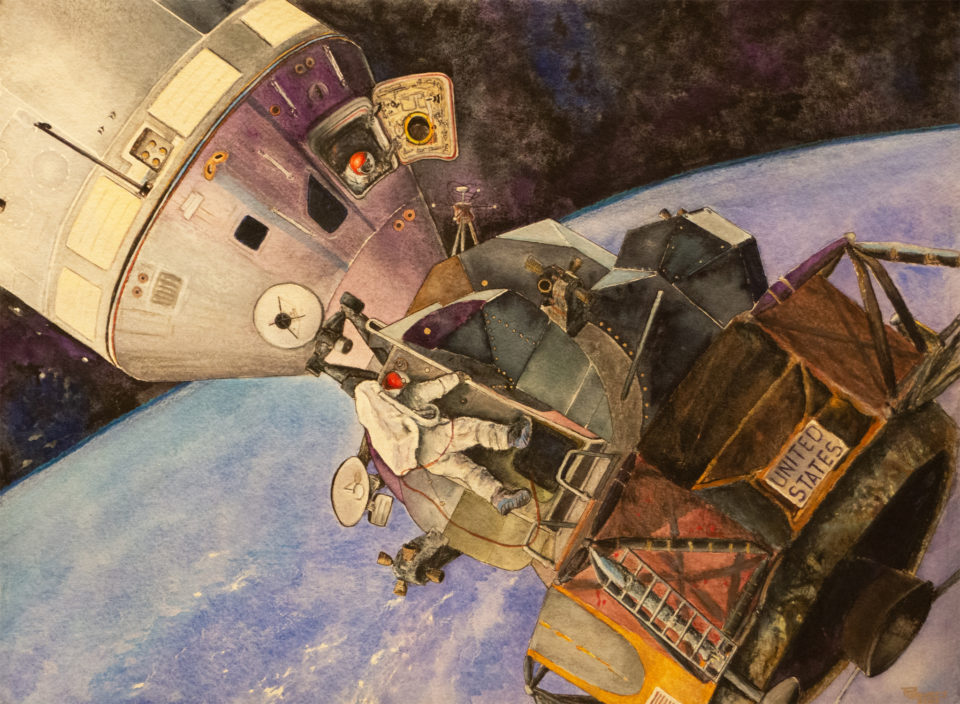
“Dress Rehearsal”
Watercolor and Colored Pencil 17 x 23
“Dress Rehearsal” commemorates the 50th anniversary of Apollo IX in the NASA three-astronaut-crew program. Its mission was to maneuver the first flight between the Command and Service Module (CSM) and the Lunar Module (LM) and prove the LM worthy of crewed spaceflight. The three-person crew consisted of Mission Commander James McDivitt, Command Module Pilot David Scott, and Lunar Module Pilot Rusty Schweickart. The artwork depicts Rusty Schweickart’s first spacewalk on the LM and David Scott peeking out of the CSM.
3rd Place

“Lunar Landing Research Vehicle”
Acrylic 20 x 16
Lunar Landing Research Vehicles (LLRV), simulators for the Moon landings, were used by NASA’s Flight Research Center, Edwards Air Force Base, California, to study and analyze piloting techniques needed to fly and land the Lunar Module. The vertical take-off vehicles used a jet engine mounted on a gimbal so that it always pointed vertically, and used hydrogen peroxide thrusters for directional control and stability. Two LLRVs and three Lunar Landing Training Vehicles, built by Bell Aerosystems, were flown at Ellington Field, Texas. One LLRV and two LLTVs were destroyed in crashes, but all the pilots, including Neil Armstrong, ejected safely.
MILITARY
1st Place
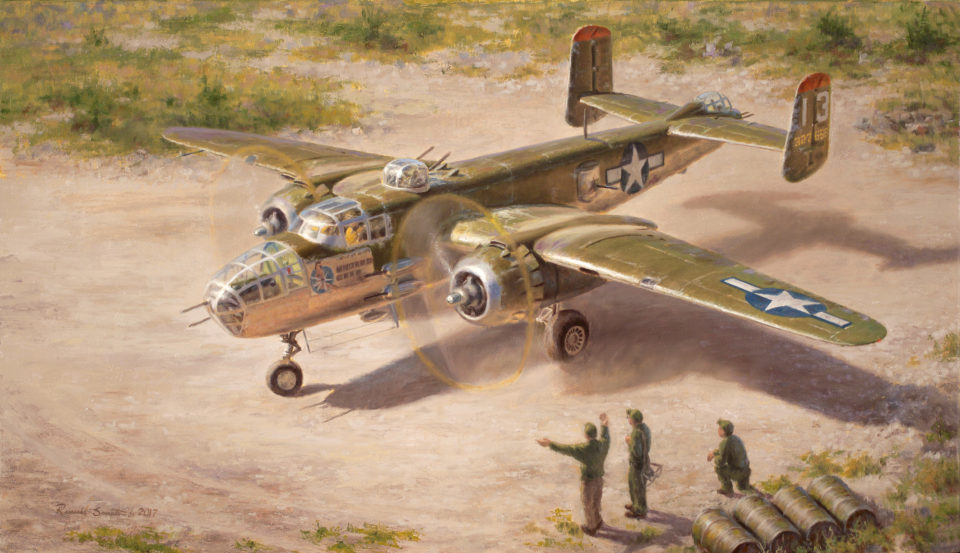
“Peggy Lou”
Oil 16 x 28
Peggy Lou depicts a Ninth Air Force B-25J of the 445th Bomb Squadron, 321st Bomb Group based in Falconara, Italy in early 1945.
2nd Place
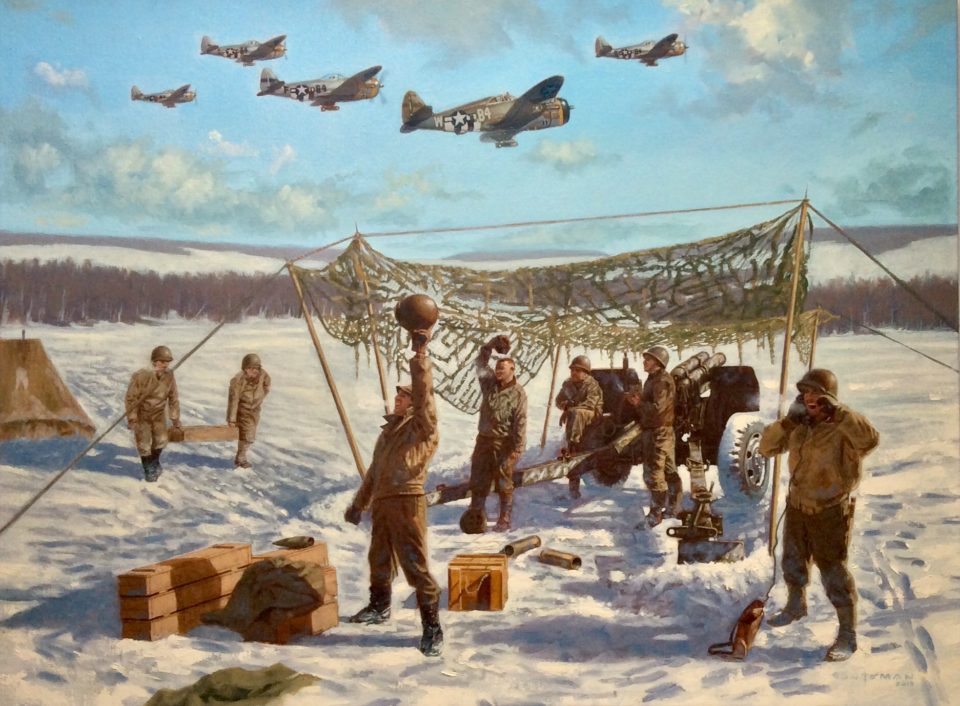
“Turning Point”
Oil 20 x 30
During the Battle of the Bulge the Allied forces were completely caught off guard by the swiftness and ferocity of the German advance. The German push towards Antwerp, the Allies key port of supplies, had created a “bulge.” A young 1Lt from the 109th field artillery unit of the 28th Infantry Division, better known as the “Bloody Bucket (Keystone) Division,” was involved in the initial fighting during the German advances. On the morning of December 24th the weather finally cleared and the tide would drastically turn in the Allies’ favor. P-47s from the Hell Hawks were up in the air destroying targets of opportunity immediately as crews cheer the turn of events. This would become the turning point of the battle.
3rd Place
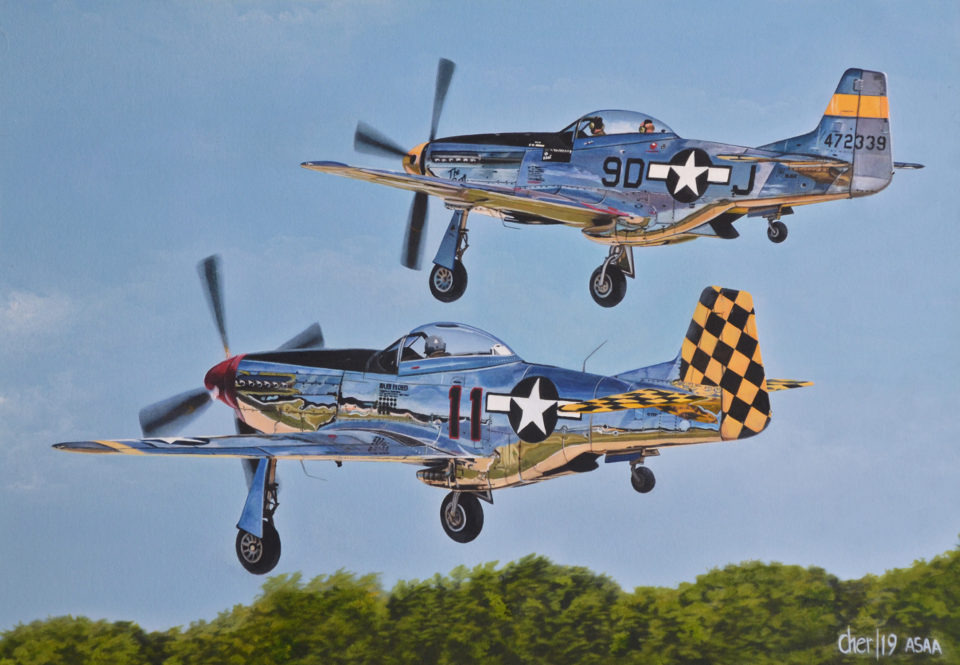
“P-51s”
Acrylic 10 x 14
These Mustang P-51Ds, polished right up, take to the sky at Oshkosh in 2013.
GENERAL AVIATION
1st Place

“Show Time”
Acrylic 10 x 16
What a wonderful display of talent when Skip Stewart and Mellisa Pemberton took to the sky at Air Venture in 2015. Skip was flying his Pitts S-2S special, and Mellisa in her 2005 Edge 540!
2nd Place

“Last Flyer”
Oil 18 x 48
Only about 50 of this unusual low-wing Aeronca were built. Its distinctive Art Deco style was a departure from Aeronca’s normal high-wing light airplanes. NC 16262 is the last flying survivor of its type.
3rd Place

“Reagan National this is Breeze on final with landing light on”
Oil 24 x 36
Enjoying an evening flight, Grampa and grandson are landing at Reagan National Airport. “Tower this is Breeze on final, landing light is on.”
BOEING SPIRIT of FLIGHT

Cher Pruys “P-51s”
Acrylic 10 x 14
These Mustang P-51Ds, polished right up, take to the sky at Oshkosh in 2013.
WINSOR NEWTON

“Denali and the Helio Courier”
Watercolor 30 x 22
This image is part of the ‘Denali’ series currently on my drawing board. This Alaskan mountain has many faces, perfect for providing continuous inspiration. For search and rescue purposes, many aircraft are painted red. Watercolor seemed the perfect medium to capture the crisp, cold scene.
DUANE WHITNEY MARTIN AWARD

“Super Sabres Respond – Tet ‘68”
Oil 30 x 48
Early morning on January 31st, 1968, Bien Hoa Air Base, Vietnam, found itself under heavy ground attack as part of a country-wide Viet Cong and North Vietnamese Tet Offensive and had overrun about 20% of the base. By mid-morning USAF and US Army ground forces had repelled the enemy who continued to fight to the east. Enemy casualties and debris littered parts of taxiways and runways preventing the alert F-100’s from taking off until early evening. One of the first fighters airborne was F-100D 56-3440 shown as it lifts off into the evening twilight under intense hostile ground fire. This aircraft flew in combat from 1965-1970 and is on permanent display at the Smithsonian Udvar-Hazy Air and Space Center in Chantilly, Virginia.
GALLOWAY AWARD

“Boeing 314 Clipper”
Oil 15 x 30
The Boeing 314 Clipper was a long-range flying boat produced by the Boeing Airplane Company between 1938 and 1941. One of the largest aircraft of the time, it used the massive wing of Boeing’s earlier XB-15 bomber prototype to achieve the range necessary for flights across the Atlantic and Pacific Oceans. Twelve Clippers were built; nine were brought into service for Pan Am.
FOREFEATHERS
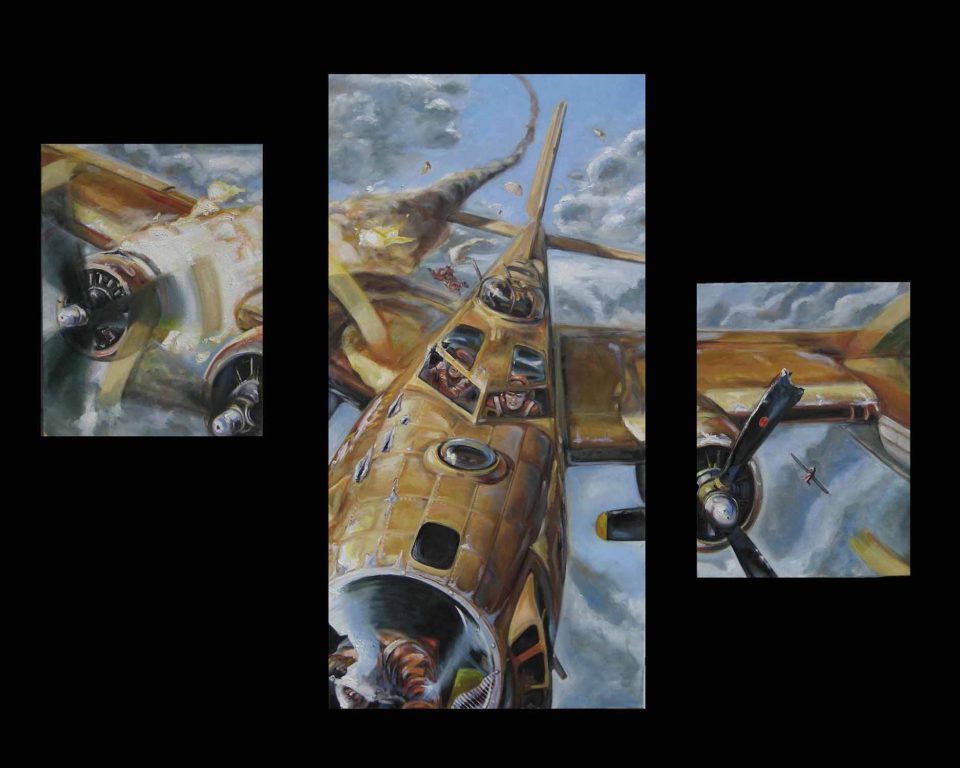
“B-17”
Oil 48 x 67
A pilot fights to give his crew the chance to escape their stricken B-17.
ASAA Unjuried Show
FOUNDERS RECOGNITION
Sean Hampton

F-117
ASSOCIATE RECOGNITION

FOUNDERS SILVER

Smokey the War Dog
FOUNDERS SILVER

B-52
FOUNDERS GOLD

Wildcat
JEFFERIES UNJURIED WORK–
“PEOPLES CHOICE”
 Greg Jackson
Greg Jackson
Smokey the War Dog
JEFFERIES UNJURIED WORK
Created on Site

Richard Wheatland
PBY
